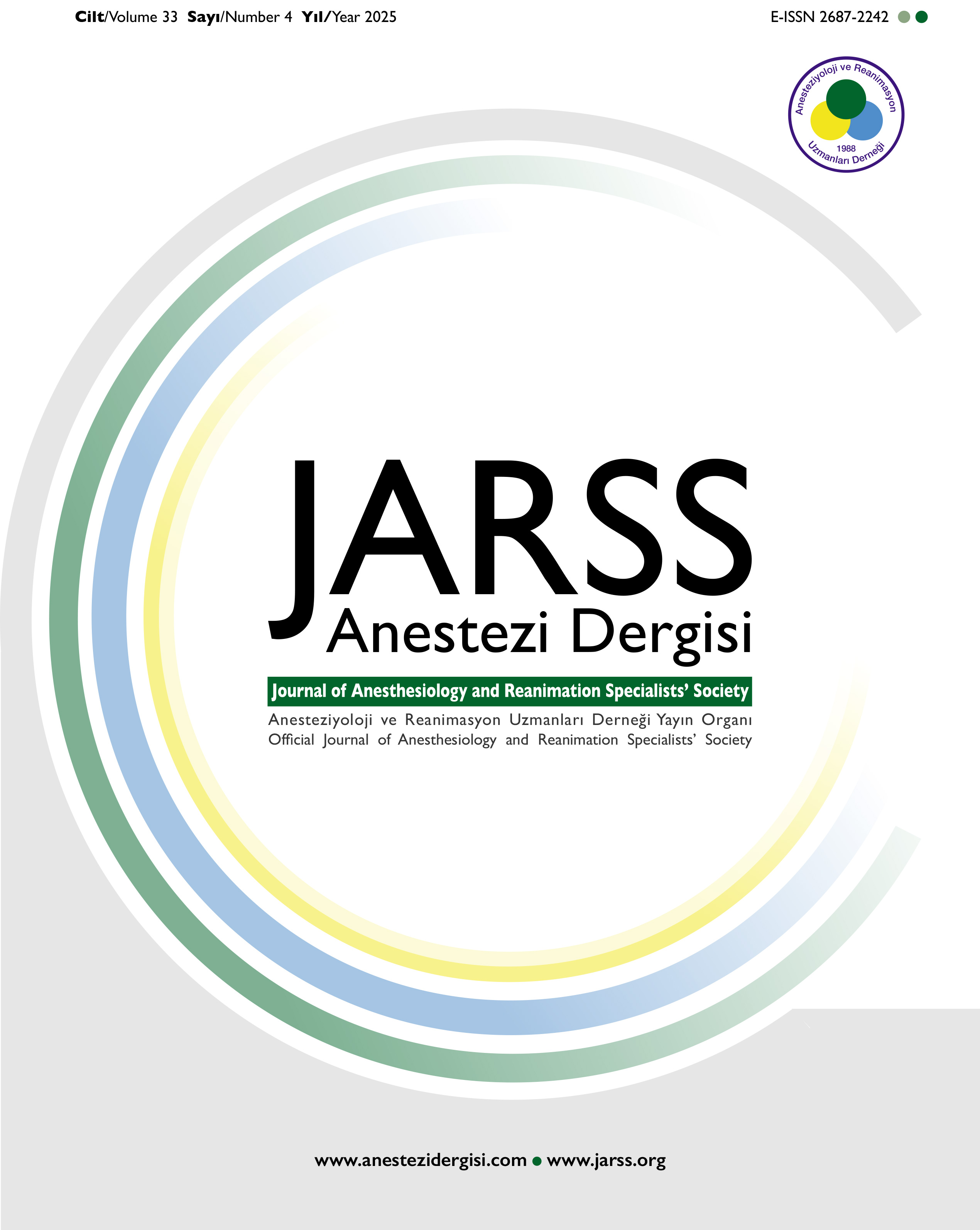Çocuklarda İntraoperatif Uygulanan Analjezi Yöntemlerinin Postoperatif Erken Deliryuma Etkisinin Değerlendirilmesi
Mehmet Değermenci1, Ali Altınbaş2, Dilek Yeniay1, Aysel Yucak3, Pınar Tekin41Giresun Kadın Doğum ve Çocuk Hastalıkları Eğitim ve Araştırma Hastanesi, Anesteziyoloji ve Reanimasyon Kliniği, Giresun, Türkiye2Giresun Üniversitesi Tıp Fakültesi, Anesteziyoloji ve Reanimasyon Ana Bilim Dalı, Giresun, Türkiye
3Giresun Üniversitesi Tıp Fakültesi, Pediatrik Cerrahi Ana Bilim Dalı, Giresun, Türkiye
4Yenice Devlet Hastanesi, Anesteziyoloji ve Reanimasyon Kliniği, Çanakkale, Türkiye
Amaç: Postoperatif erken deliryuma (ED) neden olan faktörler tam olarak bilinmemekle birlikte ağrı, preoperatif anksiyete, cerrahinin tipi, hastanın kişisel özellikleri, uygulanılan anestezik ajanların etiyolojide yer aldığı düşünülmektedir. Biz de çocuklarda görülen postoperatif ED’nin, kullanılan analjezi yöntemleri ile ilişkisini araştırarak özellikle kaudal analjezinin postoperatif ED’yi azaltıcı etkisinin olup olmadığını değerlendirmeyi amaçladık.
Yöntem: Çalışmamız 3-8 yaş aralığında, ASA I ve II risk grubunda, elektif inguinal herni, hipospadias, inmemiş testis ameliyatı olan hastalarda çift kör, randomize, prospektif olarak gerçekleştirildi. Hastalara standart anestezi indüksiyonu yapıldıktan sonra larengeal maske yerleştirilip anestezi idamesi %2-3 sevofluran ile sağlandı. Hastalar, cerrahi başlamadan önce kaudal blok yapılanlar (Grup K) ve cerrahi sonunda intravenöz analjezi uygulanılanlar (Grup I) olmak üzere gruplandırıldı. Çalışmadaki tüm hastaların cerrahi süre, anestezi süresi, derlenme süresi, postoperatif 5., 10., 20., 30. dakikalarda Pediyatrik Anestezide Derlenme Deliryumu (PAED) ve Davranışsal Ağrı Değerlendirme Skalası (FLACC) skorları yanı sıra bulantı, kusma, desatürasyon gibi komplikasyonlar kaydedildi.
Bulgular: Çalışmamıza toplam 60 hasta dahil edildi. Postoperatif takiplerde 18 hastanın (%30) en az bir kez PAED skoru>12 olarak değerlendirildi. Gruplar arasında PAED skorları açısından anlamlı fark olmadığı görüldü. Postoperatif 5. dk’ da 14 hasta, postoperatif 10. dk’da 8 hasta, postoperatif 20. dk’da 3 hastada ED olduğu görüldü. Postoperatif 30. dk’da ise hiçbir hastada ED görülmedi ayrıca gruplar arasında ED görülme sıklığı açısından anlamlı fark yoktu.
Sonuç: Postoperatif ağrı tedavisinde uygulanılan kaudal blok ile iv opioid tedavisi arasında ED gelişmesi açısından fark bulunamadığı çalışmamızda görülmüştür.
Anahtar Kelimeler: Erken deliryum, kaudal blok, postoperatif ağrı
Evaluation of the Effect of Intraoperative Analgesia Methods on Postoperative Early Delirium in Children
Mehmet Değermenci1, Ali Altınbaş2, Dilek Yeniay1, Aysel Yucak3, Pınar Tekin41Giresun Gynecology and Pediatrics Training and Research Hospital, Anesthesiology and Reanimation Clinic, Giresun, Türkiye2Giresun University Faculty of Medicine, Department of Anesthesiology and Reanimation, Giresun, Türkiye
3Giresun University Faculty of Medicine, Department of Pediatric Surgery, Giresun
4Yenice State Hospital, Anesthesiology and Reanimation Clinic, Çanakkale, Türkiye
Objective: Although the factors causing early postoperative early delirium (ED) are not known exactly, pain, preoperative anxiety, type of surgery, personal characteristics of the patient, and anesthetic agents administered are thought to be involved in the etiology. We aimed to investigate the relationship between postoperative ED in children and the analgesia methods used and to evaluate whether caudal analgesia has a decreasing effect on postoperative ED.
Methods: Our study was performed prospectively, randomized, double-blind, double-blind, in patients aged 3-8 years, in the ASA I and II risk groups, who underwent elective inguinal hernia, hypospadias and undescended testis surgery. After standard anesthesia induction, a laryngeal mask was placed and anesthesia was maintained with 2-3% sevoflurane. Patients were grouped as those who underwent caudal block before surgery (Group K) and those who received intravenous analgesia at the end of surgery (Group I). Duration of surgery, duration of anesthesia, recovery time, Pediatric Anesthesia Recovery Delirium (PAED) and Behavioral Pain Assessment Scale (FLACC) scores at 5, 10, 20 and 30 minutes postoperatively,as well as complications such as nausea, vomiting, and desaturation were recorded for all patients in the study.
Results: A total of 60 patients, were included in our study. In the postoperative follow-up, 18 patients (30%) were evaluated at least once with a PAED score >12. There was no significant difference in PAED scores between the groups. Early Delirium was observed in 14 patients at postoperative 5 min, 8 patients at postoperative 10 min and 3 patients at postoperative 20 min. At postoperative 30 min, no ED was observed in any patient and there was no significant difference in the frequency of ED between the groups.
Conclusion: Our study showed that there was no difference between caudal block and iv opioid therapy in the treatment of postoperative pain in terms of the development of ED.
Keywords: Emerge delirium, caudal block, postoperative pain
Makale Dili: Türkçe
(431 kere indirildi)












